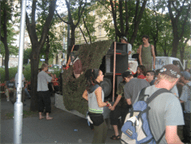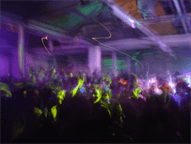The return of the illegal rave - why it could be a good thing
Wednesday, June 15, 2016
by Tat
Previously in Trackhunter we put forward the hypothesis of whether the illegal acid house parties could have happened in the internet age. We came to the conclusion that it would have struggled to have happened on the huge scale it did because of information being leaked across the social web. Yet in recent months there have been stories coming out in the media about large illegal raves taking place. Of course illegal raves have always happened, whether it be 100, 1000 or 10,000 people dancing in a disused building or far flung field. Many gatherings capture the essence of the illegal rave, private parties, festivals and club nights, they all have a common theme, that they are unlicensed and often organised at the last minute. Sadly however, like the first generation of parties they have rarely had any precautions in place should things go wrong.
The first generation of acid house
Acid house parties of the late 80s and 90s eventually came to an end because of a collection of reasons. They were too big, too many, hijacked by undesirable forces, criminalised and finally that the emergence of the super club drew people back inside to party. The media bandwagon demonised a whole generation, when in fact it harmonised people from different social, ethnic and economic backgrounds. Rave did more for racial harmony in the UK than any government initiative. Their rapid growth in numbers and size made them appear on the radars of the Tony Government in power who were quite to impose legislation and a strong arm to shut many down. Twenty five years on we are still under a Tory rule, people are discontent and there is still a strong desire to dance all night long. Whilst various stories have appeared in the national media recently about large illegal raves it is important to ask why, and what lessons can we learn from a quarter of a century ago?
The return of the illegal rave
Of course we don't think illegal raves ever went away, they have always been there, often appearing in the dead of night in some remote part of the UK countryside. Yet they have never reached the zenith that they did in the early 1990s when the scene broke up into smaller disparate music tribes. Many of the illegal raves that continued were run by travellers and disenfranchised groups of society who had no intention of popping on a pair of smart shoes and heading off to Gatecrasher or Renaissance.
Recently there have been media reports of large raves all around the UK. In May a large party kept the residents of the Somerset town of Frome awake all Saturday night. The police were mostly powerless to shut it down after the rave had got into full swing. In this case the police allowed the party to continue and contain it due to the size of the gathering and prevent anyone else joining it. They later admitted that the party could have been effectively been shut down if they had got advance warning. ITV News published a story titled; "Summer brings warning of illegal raves". The story includes a quote from Northamptonshire Police reiterating the advice of their Somerset counterparts, in that once a rave starts it is hard to shut down. As with so many public services, the police often do not have adequate resource to tackle such events, especially it appears to be harming no one. Whilst this rave revival may be little more than hyped up media attention it still has the potential for problems as some raves have ended in violence and court appearances this year.
Why has the illegal rave returned?
As we said earlier they never went away, I have attended unlicensed gatherings of more than 100 people in the last few years, often in a field over the course of a few days. The big difference being with any older raver, families and children are on site, nevertheless it they were unlicensed in the eyes of the law. Thankfully these events were well organised, respectful and passed without any issues. Yet the media do seem to have latched on to something happening on the youth news wire. Despite the potential hype, there are various factors why illegal raves have returned to the media attention and in the long run good reason. Music and culture can be a fickle beast and as we have seen, it can be cyclical. Rave music and culture has never gone away and on a few occasions reappeared on the media spectrum. One of the poorer, well known attempts was New Rave which appeared a decade ago. Whilst disco, drum and bass and ambient have all gone through peaks and troughs, none of which ever truly dying away. Despite that, dance culture is constantly under pressure to reinvent itself and move on to the next best thing. Often clubs, scenes and labels are left behind to die as the masses move onto something they deem as more exciting and new. In the big scheme of things, the original acid house scene was a blink of an eye, rave lasted considerably longer.
Rose tinted spectacles
A common human trait is to look back to the past with a pair of rose tinted spectacles and dance music falls very much into that trap. Of course there is a lot to reminisce about with clubbing and dance music, great times, great friendships and awesome music. Yet the illegal rave scene was not without its problems, most notably the infiltration by criminal fraternities. Many raves never happened, some were shut down half way and there was often an underlying tension in some events. Once the shadier, darker elements got involved in the rave scene its days were numbered as a mass movement. We have to remember though, this was a DIY scene, a right of passage and by its very nature needed an edge.
Learning from lessons
One thing the modern illegal rave hosts can do is learn from the lessons of a generation before them. Many illegal raves were shut down due to a variety of reasons, one being the political climate and the Tory Government's desire to bring them to a swift end. It is hard to say how high illegal raves are on the current Tory Manifesto, but given their focus on austerity, Brexit, immigration, terrorism and privatisation of services, it is unlikely to feature in the way it did in the late 80s. Running an illegal rave in the 80s and 90s had various problems, often around security, widespread drug use, noise pollution and disruption to local communities. It is fair to say that if that is the case in 2016 and their popularity grows then they will befall the same tough measures. The trick is to do things differently and hope for the best, but that is not so straightforward. Firstly events need to be smaller than the first generation of acid house raves, smaller events means potentially less attention. Whilst security and well-being is essential, if someone falls ill, or even worse at an illegal rave because no one on site has been identified as a first aider, then it will just bring more attention on the movement. In the original illegal acid house raves, promoters were targeted by the authorities, if someone dies due to dehydration or through drugs then it's likely promoters will again be pursued. You cannot legislate against someone taking dangerous substances, this happens outside of raves, but you can have systems in place in case they do. Of course no one wants this to happen, but unlicensed events carry more risk or criminal activity. Whilst any one promoting the new wave of illegal raves needs to think about how they contain them, again a problem with the original raves were that many just became huge and unorganised. If the police arrive onto a party site they are less likely to shut it down if it looks like it is well organised. In many cases they will just let the party run to it's natural end.
A third summer of love?
Illegal raves will continue to be with us, they never went away, but if we are seeing a growth in them again it will in turn lead to more media and local authority attention. In times when clubs are closing, going out has become quite costly for many, then dancing in a disused building or field is a cheap, fun option. The youth of today are no different from the mods, punks, and ravers, they want a good time, they often don't care where that is. Dancing is a right of passage and if clubs continue at the rate they are currently doing, then we will see more parties in the countryside. The apparent growth in these events may just be a flash in the pan, or may be the start of a whole new return to the mass raves we witnessed across the UK. The cat and mouse chase by authorities is more likely to happen across social media and mobile text apps than down the M25. It could in turn lead back to a resurgence of the nightclub as whatever happens young people will always want to dance in large numbers. The growth in superclubs in the early 90s were as much about the authorities desire to kettle the youth into licensed, safer environments as it was about people tiring of running around the country trying to find a rave site, often failing in their mission. As we've discussed in Trackhunter before, clubs have been in decline for some time due to a combination of reasons, a prime reason being the pressure applied by authorities. Raves may address that issue and make it that the club debate opens up again and the pressure on legal promoters is eased. Dancing is instrumental to youth culture, where that happens only time will tell.
Find music to play at raves with Trackhunter on Mac, iOS or Windows







